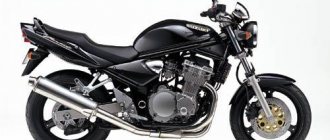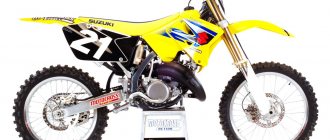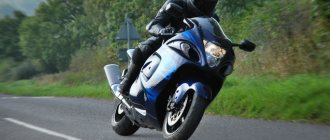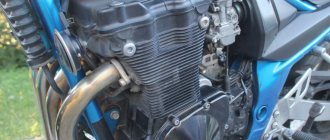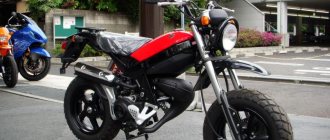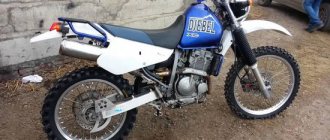Seeing the success that Kawasaki's line of Zizers (Kawasaki ZZR) received in the sports touring class, Suzuki representatives decided to keep up. Three years after the launch of competitors' models, in 1993 The Suzuki RF 400R model is introduced to the Japanese public. Just like the Zizers, in addition to the internal one, another version is put on the conveyor - with a 600 cc engine - for export.
The development turned out to be successful, the 400 cc bike sold no worse than its competitors, and later even managed to outperform them. Initially, the motorcycle was assembled on engines from Jixer (Suzuki GSX-R 400), later the line was divided into 2 directions. The second direction began to receive engines from the Suzuki GSF 400 Bandit .
Having the same parts as a more powerful model, the bike turned out to be practically indestructible. It was collected over 7 years. In 2000, the last Suzuki RF 400R rolled off the assembly line.
RF400 design
The design of the “four hundred” is based on a steel frame of a diagonal type.
For a road and at the same time sports bike, the developers decided to use steel. This solution:
- makes the structure heavier:
- makes it more durable;
- reduces the price of the final product.
For the latter, they also did not use any progressive, but untested solutions in the suspension.
The front wheel used a conventional telescopic fork (stay diameter 41 mm , stroke 120 mm ). Rear - one shock absorber on a pendulum basis (travel 125 mm ). From the settings we made adjustments for preload and rebound in the rear. The bikes of the first years also had the ability to adjust the fork preload, but a study of demand showed that this was not used and since 1995 it has been fixed , which again made it possible to reduce the price of the motorcycle.
Front fork.
Rear shock absorber.
The features of the bike include additional glove compartments in the front, a large windshield (like for sports), and a comfortable seating position.
Exterior
The model stands out from the crowd of competitors with characteristic “gills” on the sides for additional engine cooling. The decision turned out to be successful; the entire Suzuki RF line acquired it.
Front end
Low beam.
Headlight close-up.
Gills on plastic.
Steering wheel and mirrors.
- The large fender is tightly pressed to the 17-inch wheel . Above it is a small technological opening for air intake. The feathers behind the body kit are practically invisible. The last one is large, visually divided into 2 parts - the upper one with optics, glass mirrors, and the lower one, running along the motor. The dividing line is a design solution of the line, repeated on all older models.
- Here, at the level of this visual break, there are direction indicators . No frills, round buildings on their risers. Yellow in front, black in back. When trying to pack the bike, they are protected by a fault.
- The head optics are made in the form of one small square headlight . Interestingly, its size is directly proportional to the engine volume - at 600 cubic meters it is larger. There is practically no plastic underneath (before separation), above it the windshield continues, tilted back in a sporty manner. Due to the mounting, the mirrors are widely spaced, the viewing angle is good, and they do not protrude beyond the grips.
Dashboard
The release of 2 models at once had an impact here too. All blocks are the same, except that the marks on the speedometer are different.
The instrument panel is completely analogue, with four dial indicators and a block of signal lights.
This model has a speed of up to 190 km/h . In addition to the speedometer, there is a tachometer and an oil pressure indicator in front of the driver. The revolutions are marked up to 15x1000 , red from 13.5x1000 , the developers recommend 11x1000 .
All indicator lights are in a row, above the tachometer. The set is standard:
- neutral;
- turns;
- low fuel.
Back view
Rear optics.
Separate seats.
Fuel tank.
Trim on the tank.
- A motorcycle tightly sewn into plastic looks more like a sports bike . And there aren’t any tourist-specific features here either. As users note, the ergonomics of the model turned out to be unusual - neither classic nor sporty, but this does not affect the controls.
- The design of the rear optics is standard - the stop/marker is in the stem, there is a mudguard underneath, the turn indicators protrude beyond the bike using a metal strip on the mudguard. Here below is the number.
- There is no trunk , but there is space behind the second number, you can install it if you wish. Each passenger has his own saddle. The companion sits slightly higher than the driver. There is a handle for it and footrests are provided.
- The fuel tank looks huge , but holds only 17 liters , of which 3 liters is reserve, according to the standard. The head, as usual, is closed with a hatch, under which the lid itself is on the key. It is flat, the bag fits on the tank without any problems, but since it is located almost in front of the driver, holding the navigator in it can be inconvenient.
text from Motorreview No. 1, 2004:
Vladimir Zdorov,
photo:
Fot'n'RacerSuzuki RF400RV: 398 cm3, 53 hp, 180 km/h, $3500
Kawasaki ZZ-R400: 399 cm3, 53 hp, 180 km/h, $3600
Again in the crosshairs of the 400 comparative test. This time, thoroughbred sports tourists, the best-selling representatives of this class. The models are almost identical in their capabilities and characteristics, so it is very, very difficult for the average consumer to choose between them. If you are not one of those who buy according to the principle of “whatever catches your fancy,” then you will probably be interested in a number of distinctive nuances of these devices.
Clothes decide everything It’s no secret why “400s” have become the most popular class of motorcycles in our country. Increasing prices, acceptable driving performance and traditional Japanese reliability are the components of successful promotion. And the folk trail does not grow into second-hand stores. But if previously the consumer, without understanding, grabbed what looked smarter, now give him certain models, and the younger, the better. One thing, perhaps, has remained unchanged - those suffering before the “Japanese” still gravitate towards “dressed” motorcycles. That is why the share of sport bikes and sports tourists has increased in the market of used foreign cars. A good confirmation of this is our wards, Suzuki RF400RV and Kawasaki ZZ-R400, which are sold very actively in our country. And although the models belong to the category of sports “tourists,” many novice motorcyclists sign them up as sportbikes behind their backs. Which, however, is not surprising: it is very problematic to detect the tourist component of these devices packed in plastic in static conditions.
Compromises Bias is not the best of human qualities, but I can’t help it: I like the Suzuki design, and that’s it! I’ll start with it... A person who does not work with motorcycles from morning to evening will hardly be able to distinguish the youngest of the family from its larger-sized brothers - the model is identical in size to the 600 and 900 cc versions. This is certainly a good thing for our market, because the average Japanese in our country is an 18-year-old boy who only dreams of speed. This is a rare case when a domestic Japanese model meets European ergonomic requirements. The pilot's landing position on the RF is very specific, a kind of intermediate option between sports and touring. That is, compromise is a word that most accurately describes the essence and purpose of a motorcycle, literally woven from these compromises. So, despite its 100% sportbike appearance, the Susa has a steel frame, which, as you yourself understand, does not add grace to it. But it reduces the cost. But we must pay tribute to the designers, this device is successfully camouflaged and painted in the color of plastic. The engine is the highlight of the motorcycle. And it is not at all simple - it is equipped with a VC (variable valve control) variable valve timing system. Three years after the debut of the regular RF, namely in 1996, the gentlemen from Suzuki, apparently tired of reading in various meticulous magazines about the insufficient dynamics of the model, and released a modification of the RF400RV, equipped with this useful and fashionable mechanism. The upgrade did not in any way affect the increase in power characteristics, but the maximum performance was more pronounced, and the traction at low speeds improved. To be honest, it was not possible to achieve perfect results. Only on paper did the engine receive the “pickup” that is so important when riding medium-sized motorcycles. In fact, he just became normally high-torque. But what is much more important is that at high speeds the engine no longer twists into a tube due to strain. However, all this had to be tested on a specific specimen.
You may not be a “tourist”... It’s time to look at your opponent, who, by the way, is not the youngest in the ZZ-R family. Don't forget that there is a fairly successful 250cc version of the device. So, Kawasaki ZZ-R400. The external perception of the model is the same as in the case of Suzuki - you can’t immediately tell about the real engine volume: the model is identical in size to the ZZ-R600. Of course, there are nuances that the trained eye of an expert will highlight even at a hundred-meter distance, but for the average consumer they are invisible. The pilot's position is significantly different from that of the Suzuki. Firstly, the forward tilt is more pronounced here. There is an attempt to bring the landing closer to a sportier one, naturally, without the extremes of the ZXR400. Secondly, the distance to the pegs is slightly greater, which gives some relief to the lower limbs of yours truly. At the same time, the seat height of 780 mm suggests that with more or less serious inclinations, the footrests will contact the asphalt too early. As for the ease of boarding a passenger, he will have a surprisingly good time here. Although RF is still more comfortable for the second number, especially in terms of legroom. Despite the fact that the mirrors are spaced quite widely, the visibility in them is poor. But on the Suza there are no such problems, and the situation behind the device is perfectly visible. But here there is a typical “Kawasaki” gadget - hooks for luggage that are retractable into the lining - beautiful and practical. There was no skimping on the element that is most vital for handling - the frame - it is made of aluminum alloy. Well, it’s time to test the motorcycles in action, and I’ll start, forgive my bias, with Suzuki...
The tops can't, and the bottoms can't either . Perhaps the most accurate word to describe the dynamics of the RF would be “smooth.” This is exactly how acceleration proceeds leisurely and unhurriedly. Any bright “picks” promised by the VC system are practically not noticeable. I don’t know, I wasn’t particularly delighted with this “trick.” Even if they told me that she wasn’t here, I would believe it. Although the red-painted cylinder head evokes thoughts of a complex engine. Only one question remained unresolved for me. If the “charged” version drives like this, then what about the regular RF? Naturally, everything is relative. “Smooth” in my motorcycle values, which have been fairly diluted by the numerous liter sportbikes I’ve tested, means about 4.5 seconds to 100 km/h. Of course, very few, and at the same time very expensive, sports cars can boast such characteristics. But we, motorcyclists, are already accustomed to indicators of less than three seconds to “hundreds”. Alas, after 150 km/h acceleration weakens sharply. Nevertheless, the Suzuki, although lazy, accelerates to 180 km/h. Next, the electronic speed limiter comes into effect, once again emphasizing the domestic Japanese origin of the model. The device handles very confidently in a straight line and at such speeds, but, alas, there is no need to talk about any dynamics. Moreover, sixth, fifth and, perhaps, even fourth gears are here, rather, to maintain established speeds than for acceleration. If the unfulfilled ambitions of the racer haunt you, you will have to “hang” in the first three gears, forgetting that the motorcycle is equipped with a six-speed gearbox.
Trying to imagine yourself as a cool stuntrider will look completely ridiculous. The geometry of the front suspension does not allow the motorcycle to be placed on the front wheel. As for driving in the rear, the situation is as follows... Having made the engine roar heart-rendingly at almost 11,000 rpm and mercilessly throwing the clutch, from the tenth time I managed to drive 15 meters in the spark plug... Then the rev limiter worked, and, as a result, instead of a soft landing, there was a dull blow to the front fork, followed by its breakdown. So the sportbike components in the model are minimal. No, of course, if the spirit of an unrealized mechanic is also alive in you, go for it... However, there is no less positivity in RF. Excellent wind protection is a kind of bonus for the over-developed plastic cladding, and the front fork, which annoys me with deep dives during hard braking, perfectly “swallows” all sorts of road rubbish. Only the longitudinal cracks force you to strain a little, in them the motorcycle begins to live its own life - hello to the steel frame.
The peculiarities of the weight distribution of the device are such that the rear brake is quite appropriate here, and in general the braking dynamics left a very pleasant impression. Despite its relatively modest weight (186 kg), in corners I encountered behavior so well known to me from the habits of my older 900 cc sister. “Sousa” strongly resists deep bends. It has to be forced into a turn. After driving like this for a while, you begin to get used to it and stop feeling the noticeable inertia of the car when cornering. It seems like 400 cm3, but with active driving, fuel consumption easily reaches 8 l/100 km, so a 17-liter tank is often not enough for such an appetite.
With the grace of a hippopotamus Before the impressions disappear, like migratory birds, I immediately change to Kawasaki. Having mentally prepared myself for the fact that I would now have to eat the same dish prepared by another chef, I was somewhat surprised. A rather similar acceleration to 8000 rpm suddenly turned into, albeit not so pronounced, but still into “catch.” Having habitually reached the “maximum speed” of 180 km/h, strangled by the cunning Asians, I discovered that the wind protection was slightly better than that of the RF. And in general, after 150 km/h the device looks somewhat livelier than its competitor. Despite the more progressive frame design, the Kava demonstrated the grace of a hippopotamus in turns, and after a very hearty meal. In general, by modern standards, 195 kg of dry weight for a 400 cm3 motorcycle is simply indecent. Therefore, driving on winding roads is clearly not the ZZ-R's element. The downside: considerable mass contributes to good stability when driving on long straights. And such serious aerodynamic interference as oncoming trucks have almost no effect on the chosen course. Indeed, in front of me is a small-capacity “tourist”. Moreover, a relatively large 18-liter tank also works for this image. And fuel consumption turned out to be very moderate: on average, during the test the motorcycle consumed about 6 l/100 km.
The suspensions, like those on the Suza, are tuned for a comfortable ride. At the same time, as a payment for convenience, deep dives of the front fork are noticeable during any serious braking, as well as an almost complete loss of damping properties when driving with a passenger. The solution here seems to be this: the passenger should be a slender girl weighing about... hmm... well, let's say, no more than 45 kg... I myself know that such people are “found” mainly in fashion magazines. But even an individual worthless in everyday affairs, such as a motorcycle journalist, has the right to dream. The scrape of the left footrest on the asphalt confirmed my fears that they were not located high enough from the ground. On the other hand, passenger legroom is noticeably greater than on the RF. A cold mind resisted the reflexive actions of the right hand, which in vain was twisting the throttle inside out (the left hand was busily throwing the half-squeezed clutch at that time), but what can you do, a test is a test... The Zizer was a little more fun than the Suza went in the back. This procedure is also much easier for him. And in general, it is possible to drive on the rear wheel for quite a decent 50-60 meters in this case. But I’ll emphasize once again that such modes for 400 cc engines are complete violence and do not pass without a trace. Anyone in doubt should read the report on the operation of the Suzuki SV400 in the last issue.
Probably the best word to describe the difference between the cars is a little. I'll resort to him again. The gearbox works a little harder than on the RF, but overall it’s quite decent, especially for Kawasaki, which is “famous” for constant “jambs” in these units. As for braking performance, the cars are very similar. There are minor differences, rather at the level of nuances... Suzuki is a little better.
One rides, the other gallops When I was testing motorcycles, a strange allegory came to my mind. After all, these models are nothing more than reusable tour packages. Moreover, their market value is very attractive, and therefore the vouchers can be assigned the status of “hot”. In these cars, in fact, you can go on a trip, both long and short. The models have proven their tourist qualities 100%. But which ticket (read – device) to choose? It was not possible to identify a clear leader, nor, indeed, an outsider. When choosing a particular motorcycle, the question of external perception arises (as well as the tour operator’s office). Here Kawasaki is probably preferable. Because its design is still a little more modern. And the engine, despite the nominal “frailty” of a whole “mare” in comparison with the Suzuki, actually looks more fun. On the other hand, RF can respond with a more clearly operating gearbox and brakes. And we certainly shouldn’t forget about providing motorcycles with spare parts: both models are analogues of their 600 cc versions, so the only difficulties will be when ordering motor parts. As a result, the competitors' scores are almost equal. The final choice should be based on the overall condition of the particular vehicle, as well as personal preferences, which, despite everything, make me like the Suzuki RF400 RV. After all, some people like to go to Turkey every year, while others like to go to Egypt.
Kawasaki ZZ-R400: 399 cm3, 53 hp, 180 km/h, $3600 Previous photo Next photo
Suzuki RF400RV: 398 cm3, 53 hp, 180 km/h, $3500 Previous photo Next photo test evaluation pros/cons
Kawasaki ZZ-R400 Dynamics This is indicated by a slight “pickup” after 8000 rpm Comfort Not yet a “Cadillac”, but no longer WV Ergonomics I want to be an athlete Brakes I hardly need more Drive Spin me! What a pity?
Suzuki RF400 RV Dynamics And I'm not in a hurry Comfort The main thing is not to fall asleep Ergonomics A full-fledged “tourist” Brakes For such dynamics there is more than Drive What are you talking about?
Kawasaki ZZ-R400 + Very comfortable. Rigid frame, informative brakes. The power unit is characterized by elasticity of operation, and at the same time there is a “sporty” note at high speeds. The smooth operation of the checkpoint is a pleasant exception to the rule. Suzuki RF400 RV + Excellent ergonomics and wind protection emphasize touring capabilities. The traction characteristics of the motor are impressive; the VC system allows you to call this device a motorcycle with a twist. Powerful brakes. Kawasaki ZZ-R400 – Suspension tuning eliminates active driving rhythm and somewhat spoils the impression of handling, especially in corners. The front “telescope” sometimes breaks through potholes. Excess dry weight affects acceleration dynamics. Suzuki RF400 RV – The car provokes high-speed driving, but the soft chassis does not allow you to do this to the fullest. The steel frame and puncture-prone front fork can cause you to fall over when cornering. High-frequency vibrations from the power unit are also noticeable on the footpegs and steering wheel. Suzuki RF400RV parameters: 398 cm3, 53 hp, 180 km/h, $ 3500
Options Model Kawasaki ZZ-R400 Suzuki RF400 RV Debut/start of production, 1990 1996 Dry weight, kg 195 186 Curb weight, kg 220 209 Dimensions, mm 2070 x 695 x 1175 2115 x 700 x 1180 Base, mm 1430 1430 Seat height, mm 780 775 Ground clearance, mm 120 115 Front fork angle 24 23 Engine 399 cm3, 4-stroke, 4-cylinder, DOHC, 4 valves, liquid cooling 398 cm3, 4-stroke, 4-cylinder, DOHC, 4 valves, liquid cooling Dimension, mm 57.5 x 38.5 56 x 40.4 Supply system 4 Keihin CVKD30 carburetors Mikuni BST 32 Power, hp / rpm 53/11000 53/11000 Torque Nm / rpm 37/10000 38/9500 Transmission 6-speed gearbox, multi-plate wet clutch, chain Frame diagonal, aluminum alloy single, steel Front suspension telescopic fork, Ø 43 mm, travel 130 mm telescopic fork, Ø 43 mm, travel 120 mm Rear suspension pendulum, monoshock absorber, stroke 120 mm pendulum, monoshock absorber, stroke 125 mm Front brake 2 discs Ø 298 mm, 4-piston caliper Rear brake 1 disc Ø 240 mm, 2-piston caliper Front wheel 120/60-17 120/70-17 Rear wheel 160/60-17 Gas tank volume, l 18 17 Maximum speed, km/h 180 Fuel consumption, l/100 km 3,7 4,9
Specifications
Cylinder block.
An exhaust manifold.
Filler plug.
Cooling radiator.
Dividing the model into two directions allowed the bikes of the new wave to get good traction at the bottom, but this did not affect the overall picture. The Dzhikser engine had 4 strokes , 4-cylinders with an in-line arrangement and could not jump higher than its head:
- Working volume - 398 cm3.
- Power - 53 hp
- Maximum torque - 37.0 Nm.
- Number of valves - 16 (4 per cylinder).
- Cooling is liquid.
- Fuel supply - Mikuni carburetor.
- Ignition is transistorized.
- Start - electric starter.
Users note that the bike is quite picky about fuel quality. AI-92 accepts, but goes reluctantly.
Stock muffler.
Direct flow option.
Transmission and clutch
The motorcycle was equipped with a 6-speed gearbox. According to users, fast dynamics are not for this box. Gear ratios are spread across the entire rev range. It works well, switches clearly. True, neutral is sometimes difficult to catch.
- Multi-plate clutch , oil bath, power transmission - cable.
- Main drive - chain.
The chain is covered with a protective shield on top.
Brakes
Disc hydraulics are supported by 2-piston calipers. The only difference is the diameter and number of disks.
Front brakes.
Rear brake.
Front: brakes
- number of disks - 2;
- diameter - 290 mm;
- support - 2-piston.
Rear brakes
- number of disks - 1;
- diameter - 240 mm;
- support - 2-piston.
No options provided.
Features of the Suzuki SV400 model
Thanks to its compactness and low weight, the SV400S is fast and maneuverable .
The motorcycle has excellent dynamics (accelerates up to 140 km/h without visible effort) and handling, and behaves stably on the road.
The design allows the driver to sit as comfortably as possible. Responsive and informative suspensions with a wide range of settings cope equally well with both asphalt and dirt surfaces.
This is also facilitated by effective brakes; the 16-liter tank provides a sufficient power reserve.
The proposed model range of the Ural Solo motorcycle is presented in several options.
This model will be a real find for collectors of Soviet motorcycles - the shape, base, style and chassis correspond to that time.
Driving performance
The maximum speed announced by a company representative is 190 km/h . The bike has become one of the few where the maximum mark on the speedometer corresponds to the declared data.
Despite the opinion of users about poor dynamics, the motorcycle reaches 100 km/h when accelerating from a standstill in 4.9 seconds .
Fuel consumption
The developers describe fuel consumption in a rather funny way. If you drive (it is not clear where) at a city speed of 60 km/h , then the consumption will be a record 2.5 liters .
In the city (at the same speed) - already 6.5 liters .
The route is up to 5 l .
Approximate cost
On the secondary market, this bike can be bought for about 80,000 - 200,000 rubles.
New motorcycles are not officially supplied to Russia ; they can only be purchased by order.
In Russia, the model from Suzuki - SV 400 C has many fans.
Despite the fact that the debut took place more than 15 years ago, the popularity of the model still remains high.
Both the “Japanese” version (SV400) and the “export version” (SV650) are in demand.
The company’s successful attempt to create a road motorcycle is the Yamaha Tricker 250, with the possibility of using it in a “trial”.
Review of a model that attracts attention:
Dimensions and weight
When viewed from the side, the motorcycle strongly resembles a sports bike, which in fact it is half of it.
Despite the smaller engine volume, the RF400 is able to compete with its older brothers and, which is understandable, by designing 2 bikes in parallel, the designers did not think twice and the 400 received the same parts as the 600, and then the 900.
- The dry weight of the motorcycle is 186 kg .
- Equipped, filled with all fluids - 204 kg .
Bike dimensions:
- in length - 2,116 mm ;
- width - 721 mm ;
- in height - 1,181 mm .
Seat height - 779 mm .
Wheelbase - 1,432 mm .
Ground clearance - 116 mm .
For whom is it intended?
The RF 400 successfully combines modern appearance with the comfort of a classic road bike.
As they write in some publications, the average Japanese is our 18-year-old boy who will choose exactly 400 cubes.
And the low position of the motorcycle above the ground will allow a biker of any height and build to ride comfortably.
Design
Who said "design"? For harsh enduro, this concept does not exist; the emphasis is not on a pretty appearance, but on reliability, power and the ability to overcome mud in which an Abrams tank can easily get stuck. Japanese designers hired by Suzuki think so, otherwise there is no way to explain why the Suzuki DRZ 400 looks almost indistinguishable from other enduros. And the off-road version differs visually from the SM version (supermoto, that is, motard) only in the wheels. But such motorcycles are loved not for their design, but for what they are capable of.
Modifications
The Suzuki RF 400VR model was produced in red and blue colors.
In 1996, the model was divided into 2 directions. variable valve control - also comes from Bandit . In translation - control of valve timing. This made it possible to increase traction at low levels and slightly unload the engine.
The development also received several cosmetic changes:
- stainless steel muffler;
- red brake discs;
- VC badges on tank and rear
Model code name RF 400VR .
Suzuki RF line
All models in the line were practically no different from each other in appearance, except for the stickers with the cubic capacity of the moto. Although on the 900 there were additional “gills” just in front of the driver’s seat.
In 1993, two models were put on the production line at the same time.
- Suzuki RF 400.
- Suzuki RF 600.
The third went into production a year after the start of production - in 1994.
- Suzuki RF 900.
Repair and tuning
Suzuki DRZ is reliable, and all tuning usually comes down to improving its already decent characteristics. There are plenty of offers on the Internet, but they will be of interest mainly to bikers who are well versed in the topic and know how exactly this or that part will be useful to them.
Repair
According to reviews, Suzuki DRZ rarely breaks down. It is distinguished by excellent durability, and even if it falls head over heels, it is unlikely that anything will fall off of it except the mirrors. Other breakdowns are most often caused by untimely maintenance, and they can be avoided if you take proper care of your two-wheeled friend.
Spare parts
Not everything is available, but this problem is familiar to all Russian bikers. You can find absolutely everything to order, from a clutch cable to an entire engine. Prices are comparable to those of 95% of other Japanese motorcycles.
Tuning
Often, owners of Suzuki DRZ equip the bike with protective cages, hand protection, install a lightweight exhaust system, or install other wheels . Sometimes the suspension also changes, but this pleasure is not cheap. There is enough tuning for this model, but the price of individual components can be exorbitant.
Competitors
The direct competitor is the Kawasaki ZZR 400, a well-known model from another flagship of the motorcycle industry.
Since the line was planned to push Kawasaki's ZZR development into the market, it was expected that the 400s and then the 600s would compete with each other.
Several differences between the model and Kawasaki:
- production closes in 2007 (versus 2000 for RF 400);
- aluminum frame (steel for RF);
- carburetors of our own design;
- 4-piston brake calipers;
- The diameter of the front discs is larger;
- The rear suspension has a full range of adjustments.
Prices for Suzuki RF 400
Approximate prices are as follows: a 1995-1996 model in average technical condition and with minor plastic problems costs about 85-100 thousand rubles, more recent motorcycles in well-maintained condition will cost 125 thousand and more.
Conclusion: this motorcycle is suitable for both the city and long-distance trips. Good brakes and smoother operation of the gearbox compared to the Zizer can tip the scales in favor of this model. There are no problems with spare parts; you can always find all the necessary components and assemblies on the market. We recommend it to all fans of sports tourism.
Advantages
Even a quick review of the Suzuki RF 400 shows that the bike is capable of competing with younger and more modern models.
- Ergonomics.
- Wind protection.
- Good brakes.
- Balancing, weight distribution.
- Moderate quiet riding without wheelies or stops.
Many people note that to enter a turn the motorcycle has to be pushed, but on the other hand, it is noted that the oncoming truck is practically not felt.
Motorcycle appearance
The appearance of the motorcycle can be safely defined as impeccable . The design has something in common with Honda or Ducati Monster models, but this does not spoil the overall impression.
The designers retained the basic features and spartan style characteristic of Suzuki road motorcycles, but everything else has changed significantly.
The frame, made of aluminum, is highly durable with low weight. The dimensions of the bike are quite modest : the length is only 2035 mm.
In later versions it increased to 2040 and 2070 mm, while the dry weight remained the same: 167 kg.
This size was sufficient for a comfortable position for a driver of any height. The letter S denotes modifications with a sporty pilot position .
They are equipped with plastic fairings. Visibility is improved by spherical mirrors.
The manufacturer offers different colors: red, pearlescent white, blue, silver.

